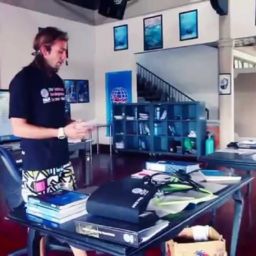Tiny New Caledonia, in the South Pacific, is a divers’ paradise. The New Caledonian Barrier Reef is one of the largest double-barrier coral reefs in the world, stretching for 930 miles (1,500 km). It encloses a lagoon 9,300 square miles (24,000 square km), and has an average depth of just 82 feet (25 m). Dive sites are suitable for both beginners and advanced divers; expect clear waters and plentiful marine life including large pelagic fish species, dugongs, sharks, manta rays and macro life. There are also numerous shipwrecks, cave diving, dive sites outside the barrier reef. In short, the best diving in New Caledonia offers something for everyone.
The water temperature varies from 71 to 78 F (22 to 26 C) from May to September and from 81 to 86 F (27 to 30 C) from October to April. Divers will need a 3mm to 7mm wetsuit, depending on the time of year and cold tolerance. Visibility is usually good, though can vary from 30 to 100 feet (10 to 30 m). There’s good diving year-round, but March through September offer the best chance to spot mantas and sharks. Here are our top picks for the best places to dive in New Caledonia.
Prony Needle
Where it is: Prony Bay, south mainland
What makes it special: From Prony Bay you can see the remains of Prony Village, a former penal work camp, along one of the inlets, nearby waterfalls, banyan forests and hot springs. The hot springs have created a tall pinnacle, the Prony Needle, which rises 131 feet (40 m) from the ocean floor to just 6.5 feet (2 m) below the surface. This pyramid-shaped pinnacle is ideal for all divers and makes for an excellent night dive as well. Expect to see plentiful corals, oysters, scorpionfish, macro life and a variety of reef fish. Spanish dancers are visible at night and the lucky diver might spot a pearly nautilus.
Details: Average dive depth is 82 feet (25 m) and those with time for a second dive should consider drift diving the Canal Woodin, where you can sometimes spot whales and sharks.
La Pointe aux Cachalots (Sperm Whale Point)
Where it is: Accessible from Hienghene
What makes it special: Those looking for an isolated and remote dive experience can visit Babou Coté Océan, where they can stay next to a small tribal village while diving sites such as Sperm Whale Point. This cave and arch site features unusual topography, with cracks in the wall reaching to the surface and creating unique light conditions for photography. Divers can expect to see moray eels, conger eels, gorgonian fans and scorpionfish. Other dive sites in this lesser-visited area include the protected Hienga Island and Doïmen Reef. Divers visiting in November can also experience the annual coral spawn.
Details: Average dive depth at Sperm Whale Point is 100 feet (30 m), with visibility of over 65 feet (20 m+) and no current. The dive sites in this area are suitable for all experience levels.
Shark Pit
Where it is: Accessible from Grand Sud, Goro
What makes it special: The Shark Pit is a well-known dive site in New Caledonia. It offers steep drop-offs, a sandy bottom, hard corals and the opportunity to see marine life such as barracuda, skates and grey reef sharks. A shipwreck lies tucked between Néaé Island and the reef.
Details: The current is strong at this site, which means it’s suitable for experienced divers only. Bring a dive guide.
Dumbea Passage
Where it is: Accessible from Noumea
What makes it special: This dive sites offers two potential dives. Canyon Fossil has varied and abundant plant life, a drop-off, gorgonians and often features hundreds of migrating groupers that congregate in small caverns during their mating season. You can make a second dive on the opposite side of the passage at M’Bere Reef, where there’s abundant fish life alongside black corals, steep canyons and a large World War II submarine mine. It is rare to dive this passage without encountering sharks, including grey reefs, whitetips, leopard sharks, hammerheads and blacktips.
Details: This very popular dive area varies seasonally. There are lots of grey reef sharks in June and the groupers lay their eggs during October and November. You’ll find the groupers in caverns at about 42 feet deep (13 m). The dives are often drifts with reasonable currents, and are suitable for experienced divers.
Amédée Island
Where it is: Accessible from Noumea
What makes it special: Amédée Island is a 45-minute boat ride across the lagoon, a UNESCO World Heritage site, and is home to the Amédée Diving Club. This center was the first to operate in New Caledonia. There are 10 dive sites to explore here, all within 20 minutes of the island. Some of the best include the Dieppoise and Toho 5 shipwrecks. A French warship sunk in 1988, the Dieppoise is home to barracudas, nudibranchs and jacks. The interior of the ship, with dining tables and chairs, is clearly visible and you can swim through the pilot house. The Toho 5, a Japanese longliner sunk in 2000, is already home to groupers and jacks.
Another nearby site, Boulari Pass outer reef, is famous for its manta rays and other large pelagic species. You may see humpback whales from July through September.
Details: The Dieppoise and Toho 5 are both at a depth of 85 feet (26 m). The Boulari Pass averages around 49 feet (15 m), with a maximum dive depth of 98 feet (30 m). Dives from Amédée Island are suitable for both novice and experienced divers.







